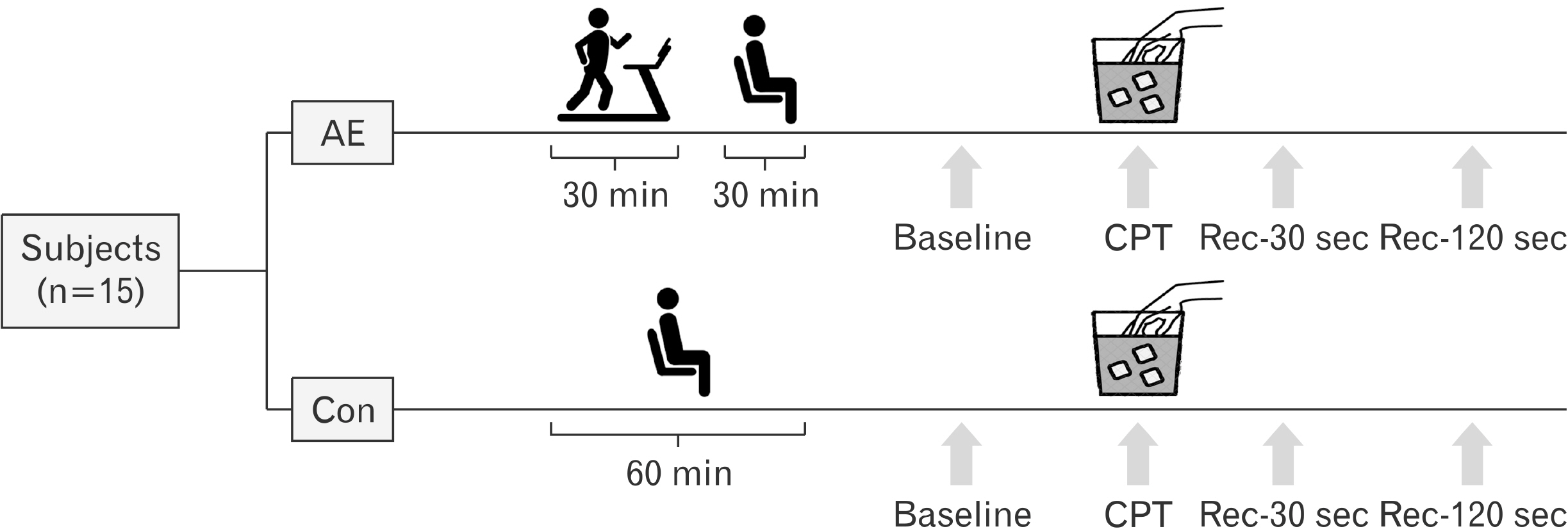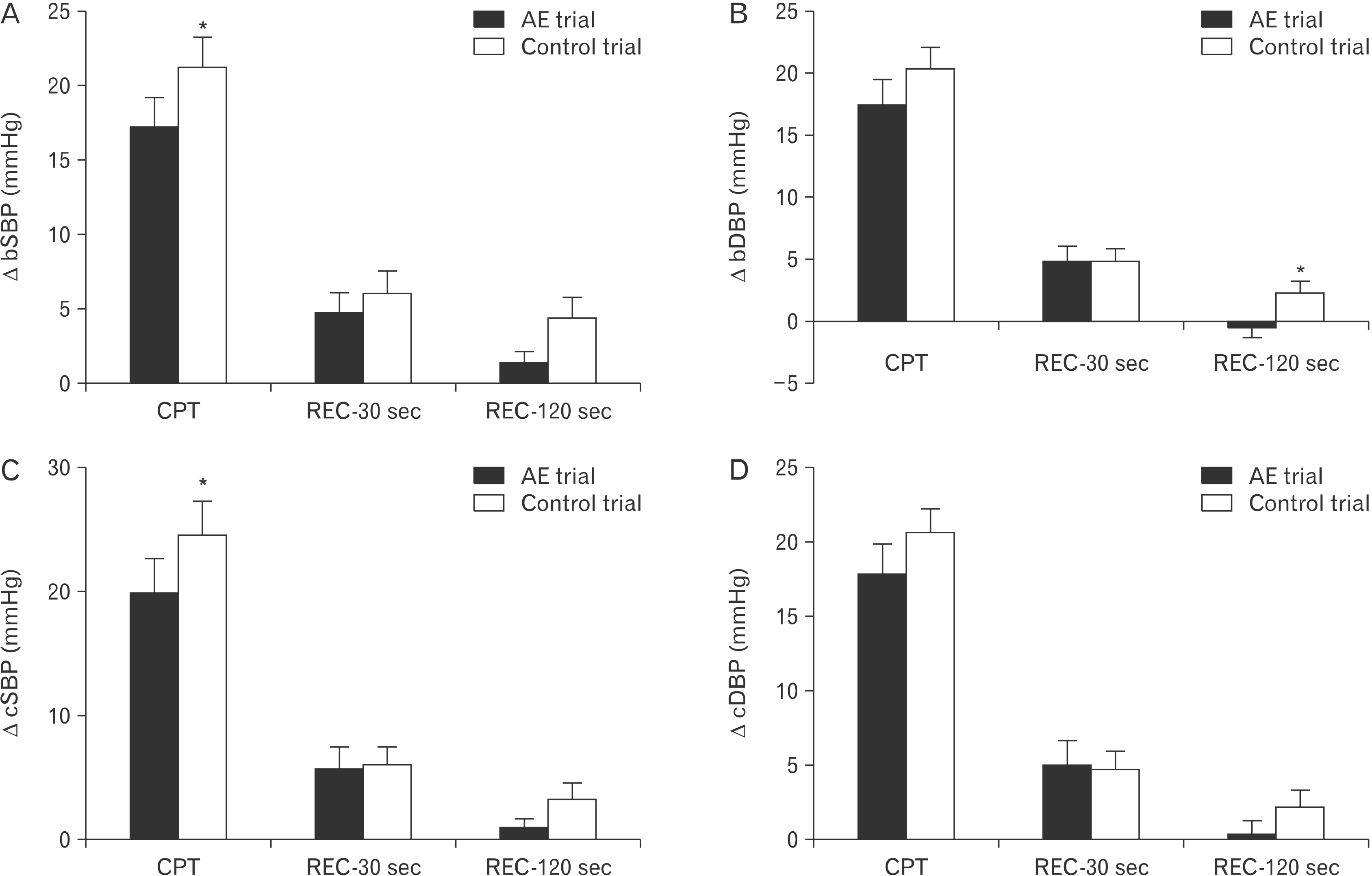Korean J Sports Med.
2021 Mar;39(1):27-33. 10.5763/kjsm.2021.39.1.27.
The Effect of Acute Aerobic Exercise on Central Blood Pressure Reactivity to Sympathetic Activation in Healthy Adults: A Randomized Crossover Trial
- Affiliations
-
- 1Department of Sport Science, University of Seoul, Seoul, Korea
- 2Graduate School of Urban Public Health, University of Seoul, Seoul, Korea
- KMID: 2513515
- DOI: http://doi.org/10.5763/kjsm.2021.39.1.27
Abstract
- Purpose
Acute aerobic exercise has been shown to attenuate brachial blood pressure (BP) reactivity to sympathetic activation, though whether it also attenuates central BP reactivity remains unclear. We tested the hypothesis that an acute bout of aerobic exercise would attenuate central BP reactivity to sympathetic activation.
Methods
In a randomized crossover design, 15 healthy adults (23±0 years and 23±1 kg/m 2 ) completed two trials; (1) acute aerobic exercise (30 minutes at 60% of heart rate reserve) and (2) sitting as a time control prior to the cold pressor test (CPT) in a randomized order. During the CPT, a hand was submerged up to the wrist in an iced water bath (4°C) for 3 minutes. Heart rate and brachial and central BP were measured at baseline, during and after the CPT.
Results
Heart rate, and brachial and central BPs increased similarly during the CPT in both trials and returned to baseline after CPT (time effect, p< 0.05). However, brachial systolic BP reactivity to the CPT was attenuated in the acute aerobic exercise trial compared to control trial (interaction effect, p< 0.05). In addition, the magnitude of central systolic BP reactivity during the CPT was less increased in the acute aerobic exercise trial (Δ 19.8 mmHg) versus in the control trial (Δ 24.6 mmHg) (p=0.017).
Conclusion
These findings demonstrated that acute aerobic exercise attenuated both brachial and central BP reactivity to the sympathetic activation, suggesting that aerobic exercise may have a favorable effect on central BP reactivity to the sympathetic activation in young adults.
Keyword
Figure
Reference
-
1. Grassi G, Seravalle G, Mancia G. 2015; Sympathetic activation in cardiovascular disease: evidence, clinical impact and therapeutic implications. Eur J Clin Invest. 45:1367–75. DOI: 10.1111/eci.12553. PMID: 26480300.
Article2. Everson SA, Lynch JW, Kaplan GA, Lakka TA, Sivenius J, Salonen JT. 2001; Stress-induced blood pressure reactivity and incident stroke in middle-aged men. Stroke. 32:1263–70. DOI: 10.1161/01.STR.32.6.1263. PMID: 11387485.
Article3. Carroll D, Ginty AT, Der G, Hunt K, Benzeval M, Phillips AC. 2012; Increased blood pressure reactions to acute mental stress are associated with 16-year cardiovascular disease mortality. Psychophysiology. 49:1444–8. DOI: 10.1111/j.1469-8986.2012.01463.x. PMID: 22958235.
Article4. Zhao Q, Gu D, Lu F, et al. 2015; Blood pressure reactivity to the cold pressor test predicts hypertension among Chinese adults: the GenSalt Study. Am J Hypertens. 28:1347–54. DOI: 10.1093/ajh/hpv035. PMID: 25824451. PMCID: PMC4612341.
Article5. Menkes MS, Matthews KA, Krantz DS, et al. 1989; Cardiovascular reactivity to the cold pressor test as a predictor of hypertension. Hypertension. 14:524–30. DOI: 10.1161/01.HYP.14.5.524. PMID: 2807514.
Article6. Pouwels S, Van Genderen ME, Kreeftenberg HG, et al. 2019; Utility of the cold pressor test to predict future cardiovascular events. Expert Rev Cardiovasc Ther. 17:305–18. DOI: 10.1080/14779072.2019.1598262. PMID: 30916592.
Article7. Panaite V, Salomon K, Jin A, Rottenberg J. 2015; Cardiovascular recovery from psychological and physiological challenge and risk for adverse cardiovascular outcomes and all-cause mortality. Psychosom Med. 77:215–26. DOI: 10.1097/PSY.0000000000000171. PMID: 25829236. PMCID: PMC4397577.
Article8. Barnett PH, Hines EA Jr, Schirger A, Gage RP. 1963; Blood pressure and vascular reactivity to the cold pressor test. Restudy of 207 subjects 27 years later. JAMA. 183:845–8. DOI: 10.1001/jama.1963.03700100071012. PMID: 13969392.
Article9. McMillan RK, Babcock MC, Migdal KU, et al. 2020; The impact of dietary sodium on sympathetic and blood pressure reactivity assessed using the cold pressor test. FASEB J. 34(Suppl 1):1. DOI: 10.1096/fasebj.2020.34.s1.07024.
Article10. Ebbesen BL, Prkachin KM, Mills DE, Green HJ. 1992; Effects of acute exercise on cardiovascular reactivity. J Behav Med. 15:489–507. DOI: 10.1007/BF00844943. PMID: 1447759.
Article11. Zachariah G, Alex AG. 2017; Exercise for prevention of cardiovascular disease: evidence-based recommendations. J Clin Prev Cardiol. 6:109–14.12. Spalding TW, Lyon LA, Steel DH, Hatfield BD. 2004; Aerobic exercise training and cardiovascular reactivity to psychological stress in sedentary young normotensive men and women. Psychophysiology. 41:552–62. DOI: 10.1111/j.1469-8986.2004.00184.x. PMID: 15189478.
Article13. Hamer M, Taylor A, Steptoe A. 2006; The effect of acute aerobic exercise on stress related blood pressure responses: a systematic review and meta-analysis. Biol Psychol. 71:183–90. DOI: 10.1016/j.biopsycho.2005.04.004. PMID: 15979232.
Article14. Sharman JE, Laurent S. 2013; Central blood pressure in the management of hypertension: soon reaching the goal? J Hum Hypertens. 27:405–11. DOI: 10.1038/jhh.2013.23. PMID: 23535990.
Article15. Laurent S, Briet M, Boutouyrie P. 2012; Arterial stiffness as surrogate end point: needed clinical trials. Hypertension. 60:518–22. DOI: 10.1161/HYPERTENSIONAHA.112.194456. PMID: 22733473.16. Milatz F, Ketelhut S, Ketelhut S, Ketelhut RG. 2015; Favorable effect of aerobic exercise on arterial pressure and aortic pulse wave velocity during stress testing. Vasa. 44:271–6. DOI: 10.1024/0301-1526/a000441. PMID: 26314358.
Article17. Ketelhut S, Milatz F, Heise W, Ketelhut RG. 2016; Influence of a high-intensity interval training session on peripheral and central blood pressure at rest and during stress testing in healthy individuals. Vasa. 45:373–7. DOI: 10.1024/0301-1526/a000560. PMID: 27594392.
Article18. Pauca AL, O'Rourke MF, Kon ND. 2001; Prospective evaluation of a method for estimating ascending aortic pressure from the radial artery pressure waveform. Hypertension. 38:932–7. DOI: 10.1161/hy1001.096106. PMID: 11641312.
Article19. Yoon ES, Park SH, Lee YH, Jae SY. 2016; Acute resistance exercise attenuates the cardiovascular reactivity to cold pressor test in healthy adults. Korean J Sports Med. 34:65–71. DOI: 10.5763/kjsm.2016.34.1.65.
Article20. Crews DJ, Landers DM. 1987; A meta-analytic review of aerobic fitness and reactivity to psychosocial stressors. Med Sci Sports Exerc. 19(5 Suppl):S114–20. DOI: 10.1249/00005768-198710001-00004. PMID: 3316910.
Article21. Pierce DR, Doma K, Raiff H, Golledge J, Leicht AS. 2018; Influence of exercise mode on post-exercise arterial stiffness and pressure wave measures in healthy adult males. Front Physiol. 9:1468. DOI: 10.3389/fphys.2018.01468. PMID: 30459633. PMCID: PMC6232940.
Article22. Ashor AW, Lara J, Siervo M, Celis-Morales C, Mathers JC. 2014; Effects of exercise modalities on arterial stiffness and wave reflection: a systematic review and meta-analysis of randomized controlled trials. PLoS One. 9:e110034. DOI: 10.1371/journal.pone.0110034. PMID: 25333969. PMCID: PMC4198209.
Article23. Alderman BL, Arent SM, Landers DM, Rogers TJ. 2007; Aerobic exercise intensity and time of stressor administration influence cardiovascular responses to psychological stress. Psychophysiology. 44:759–66. DOI: 10.1111/j.1469-8986.2007.00548.x. PMID: 17584185.
Article24. Pickering TG, Gerin W. 1990; Cardiovascular reactivity in the laboratory and the role of behavioral factors in hypertension: a critical review. Ann Behav Med. 12:3–16. DOI: 10.1207/s15324796abm1201_1.
Article25. Rosenmeier JB, Dinenno FA, Fritzlar SJ, Joyner MJ. 2003; Alpha1- and alpha2-adrenergic vasoconstriction is blunted in contracting human muscle. J Physiol. 547(Pt 3):971–6. DOI: 10.1113/jphysiol.2002.037937. PMID: 12588902. PMCID: PMC2342729.26. West SG, Brownley KA, Light KC. 1998; Postexercise vasodilatation reduces diastolic blood pressure responses to stress. Ann Behav Med. 20:77–83. DOI: 10.1007/BF02884452. PMID: 9989312.
Article27. Brownley KA, Hinderliter AL, West SG, Girdler SS, Sherwood A, Light KC. 2003; Sympathoadrenergic mechanisms in reduced hemodynamic stress responses after exercise. Med Sci Sports Exerc. 35:978–86. DOI: 10.1249/01.MSS.0000069335.12756.1B. PMID: 12783046.
Article28. Jungersten L, Ambring A, Wall B, Wennmalm A. 1997; Both physical fitness and acute exercise regulate nitric oxide formation in healthy humans. J Appl Physiol (1985). 82:760–4. DOI: 10.1152/jappl.1997.82.3.760. PMID: 9074960.
Article29. Mitchell JH. 2017; Abnormal cardiovascular response to exercise in hypertension: contribution of neural factors. Am J Physiol Regul Integr Comp Physiol. 312:R851–63. DOI: 10.1152/ajpregu.00042.2017. PMID: 28381455.
Article30. Ifuku H, Moriyama K, Arai K, Shiraishi-Hichiwa Y. 2007; Regulation of cardiac function during a cold pressor test in athletes and untrained subjects. Eur J Appl Physiol. 101:75–9. DOI: 10.1007/s00421-007-0475-y. PMID: 17492307.
Article
- Full Text Links
- Actions
-
Cited
- CITED
-
- Close
- Share
- Similar articles
-
- Acute Resistance Exercise Attenuates the Cardiovascular Reactivity to Cold Pressor Test in Healthy Adults
- Effects of Isometric Handgrip Exercise on Carotid Arterial Function and Cardiovascular Vasoreactivity Response to Sympathetic Stress in Young Adults
- Exercise Therapy for Hypertensive Patients
- Effects of Acute Resistance Exercise on Arterial Stiffness in Young Men
- Effect of Exercise on Cardiovascular Disease in Patients with Diabetes Mellitus (Aerobic vs. Resistance)



